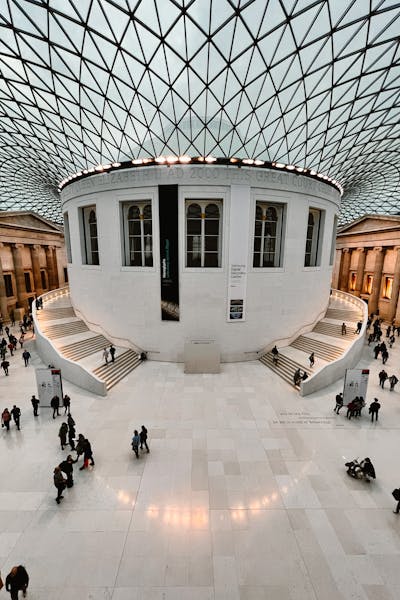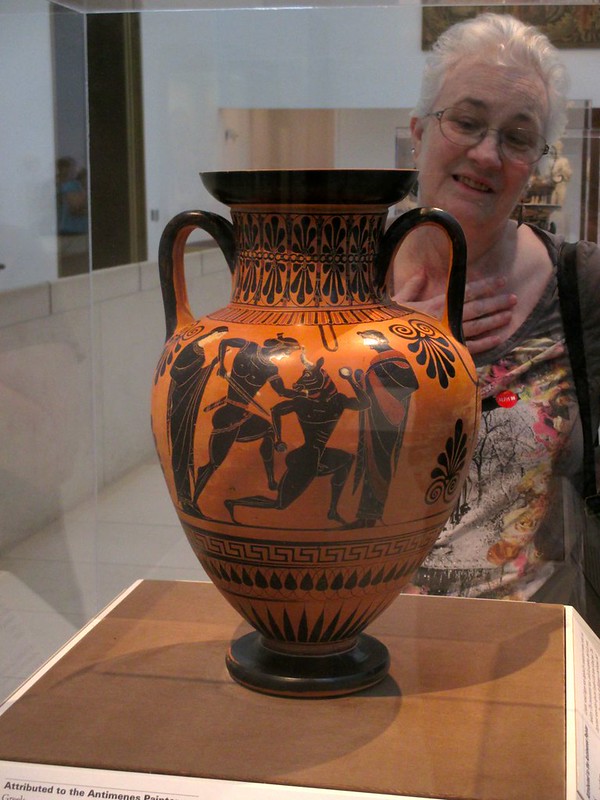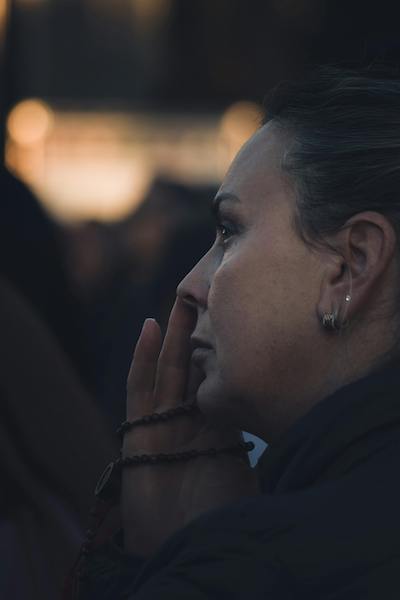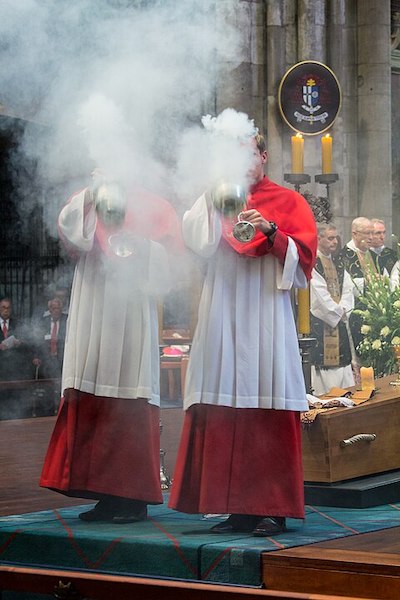Text: Luke 2.1-14
Preached at FBC Winston-Salem on December 28, 2003
One of the things my wife and I most enjoy doing together is traveling. Day-trips to state parks, road trips to visit family and friends, vacations in Europe—we love to see and explore the marvelous and diverse world in which we live. And when we travel, one of the things we most love to do is visit museums. Museums are storehouses for the harvest of human achievement, and the crop is rarely the same from town to town, state to state, and country to country. Whether it’s the Renaissance masterpieces of the Uffizi Gallery in Florence, Italy, or the taxidermy menagerie of the Jeff Matthews Memorial Museum in Galax, Virginia, we take great pleasure in sifting through the produce to see what the locals have to offer.

Sometime next year, we are planning to celebrate my graduation from McAfee by taking a trip to England, and no doubt a thick slice of our time there will be spent in the British Museum. Not only is it one of the oldest, largest, and most fabulous museums on earth, but it is also perfect for the post-seminary budget because it’s free. Kristen has never been to London, and though I have been twice before with my family I am eagerly awaiting the return trip because I have never been able to stay as long as I would have liked in the British Museum galleries. Not everyone in my family gets overly excited about 9 rooms of medieval religious relics and 27 rooms of Greco-Roman antiquities. But then again, not everyone in my family has a classics degree. Fortunately, however, my wife does have a classics degree and we don’t have to travel with my family anymore unless we want to. I can’t wait to see the look on Kristen’s face when she feasts her eyes on one of the most extensive collections of Greek pottery anywhere in the world, especially because in one of those 27 rooms, nestled among all of the amphora and sarcophagi, is one of my very favorite ancient artifacts: an Etruscan Black-figure water jar that tells the story of Theseus and the Minotaur.
Even if you know nothing else about Greek mythology, I’m sure you have heard of the Minotaur—the mutant child of King Minos of Crete who has the body of a man but the head of a bull. The story goes that Minos reneged on a vow he made to sacrifice an unblemished bull to the god Poseidon. Outraged, Poseidon cursed Minos’ wife and she gave birth to this monster as retribution for her husband’s disrespect. Minos, out of fear and shame, commissioned the famous architect Daedalus to build a labyrinth in which to house the dreadful creature, not only to keep it hidden from public view but also to keep himself and his subjects safe because the Minotaur had a voracious appetite for human flesh. Some years later, Minos defeated the Athenians in battle and imposed harsh terms of surrender upon them. Every nine years, the Athenians had to send seven young men and seven young women to Crete to be sacrificed to the Minotaur.

On one of these occasions, Theseus, son of the king of Athens, volunteered to go on the ill-fated journey, believing he could defeat the Minotaur and save his people from this horrible ritual. But in order to do so, he would not only have to slay the monster, but also find his way out of the labyrinth, which was a maze as complex and confounding as the Minotaur was grotesque. Theseus’s prospects for success were not good. However, when he arrived on Crete, Theseus had a stroke of luck. Minos’ very human and very beautiful daughter, Ariadne, fell in love with the handsome prince as he was waiting his turn to venture into the labyrinth and she decided to help him. She gave him a ball of thread and told him to unroll it as he made his way toward the center of the Minotaur’s lair. That way, if he did manage to defeat the Minotaur, he could follow the string back to the beginning of the maze and avoid the tragic fate of killing a man-eating beast only to die of hunger and thirst within the bowels of the labyrinth.
This climactic scene is the one depicted on the vase that sits in the British museum. In the center of the pot, Theseus does battle with the Minotaur while off to one side a woman looks on, holding a thin but very distinct white thread that connects her to the hero. This thread provides the only visual clue as to who has the upper hand in this gruesome struggle for life and death. The battle is undecided. Theseus is strong, but the Minotaur is fierce. Victory could easily go either way. But because we see the thread, we know that hope of victory lies within Theseus’s grasp.
I cannot imagine a better way to depict hope than the slender, wispy white line painted by this anonymous Greek artist. Hope is a powerful resource, the only thing that makes it possible for us to face many of the battles we must wage in the war of day-to-day living. All of us wander labyrinths in the depths of our souls from time to time, and if we stay in those labyrinths long enough eventually we, too, will meet a Minotaur. And when we do, we will need our own thread of hope to help us find our way out.
Paul says that “hope does not disappoint us because God’s love has been poured into our hearts through the Holy Spirit who has been given to us” (Romans 5.5), and I believe him. After all, a converted Pharisee who began to preach against everything he had always been taught, who was jailed, stoned, and shipwrecked for the sake of the gospel ought to know. But, frequently we lose sight of hope when Minotaurs loom large before us; when the sun of joy and happiness in our lives is blotted out by the low hanging clouds of disappointment and dissatisfaction, or when the road we are traveling takes a sudden detour into the valley of the shadow of death. Soon the fog of doubt and despair settles in around us and everything except that which is right in front of our face is obscured. In those moments, we quickly lose sight of hope. And I think we lose sight of it because most of us search for hope the way Groucho Marx looked for his keys. We think we have the best chance of finding it in the middle of the stage under the spotlight where the light is best and most sharply focused. But in fact I think hope is more like Ariadne’s thread. It is often most visible off to the side, in the shadows, where it shimmers in the darkness when the light catches it just right.

And that is precisely what confounds us about hope and often disillusions our faith. We expect God to be a very visible and stalwart ally in our struggles. In this way, we are no different from the ancient Israelites. We, too, want God to go before us as a pillar of cloud and fire to clearly and unambiguously guide our way. We, too, want a Messiah who will come riding into our lives on a valiant steed and wielding a magical sword to expel those things that oppress and lord it over us, and return sovereign control to our hands. Or at the very least, we want God to throw down a line of industrial strength cable from heaven and airlift us out of the midst of our confusion. We don’t want a slender thread. But that’s what we have. We have a tiny, helpless babe wrapped in swaddling clothes and lying in a manger. And perhaps that is why we are so often sore afraid in life and in faith. Like Mary and Joseph and the shepherds, we are amazed at this child whose birth we anxiously await every Christmas, but we don’t know quite what to do with Him. This is not the present we expected, and truth be told we’d like to have the receipt so we could take Him back and exchange Him for something else.
we want God to throw down a line of industrial strength cable from heaven and airlift us out of the midst of our confusion. We don’t want a slender thread. But that’s what we have. We have a tiny, helpless babe wrapped in swaddling clothes and lying in a manger.
But even we don’t realize how truly unassuming this little bundle of hope is. We have become too familiar with the Christmas story to recognize and appreciate its oddity. And often our focus isn’t really on the manger anyway. After all, the baby Jesus is the smallest piece in the Nativity and our attention is easily drawn to the snazzier elements of the drama: the star; the sharply dressed wise men; the gifts of gold, frankincense, and myrrh; the company of the heavenly host joining with the angel to sing, “Glory to God in the highest and on earth peace and good will toward men!” That’s what we really like. And that’s why I think we frequently become emotionally and spiritually depressed after Christmas. The gold gets spent; the frankincense and myrrh run out; the wise men go home; the star fades; the angels disappear; and the chorus ends. Only the tiny, helpless baby Jesus is here to stay, and He didn’t come equipped with any flashy accessories or battery-powered special effects to keep us entertained. Sure, He’s from the house of David but so are lots of other people. He can’t rest on that laurel. Even if he could it’s a laurel blighted with adultery and murder, among other things.
The other leaves in his family wreath aren’t much to fall back on, either. Many of his other ancestors, besides David, were also kings, but by and large they, too, failed to be faithful to God and eventually ran Israel to ruin. His mother became pregnant before she was married, and there are at least two prostitutes in the family. His cousin is a raving lunatic who wanders the wilderness wearing camel’s hair, eating locusts and wild honey, and blathering about repentance. With a background like that, this child shouldn’t be adored and celebrated. He should be in therapy. Now, if He were a rags-to-riches story that would be something different. We could raise a toast to that. We could hold that accomplishment up high and be proud of the little tyke who pulled Himself up by His bootstraps and made something of Himself. We could film a holiday mini-series about His life or give Him His own game show and say, “That’s who I want my kids to be like when they grow up!” But He pretty much stays in rags. He will live out His life without a place to lay His head. He will die a criminal’s death and be laid to rest in a borrowed tomb. Can the Bible be serious? This is the Messiah in whom we are to place our trust, in whom we are to have hope, hope that does not disappoint us, as Paul says?

Yes. And quite frankly, I don’t think we could truly have hope in any other kind of Messiah. Because no other Messiah could have walked where we have walked, slogged where we have slogged, and wept as we have wept. No other Messiah would have dined with both sinners and Pharisees, rich and poor, weak and strong. No other Messiah would have been free enough from wealth and power to challenge the system and stick it to the Man the way Jesus did. No other Messiah would have been rejected as we are rejected, disappointed as we are disappointed, hungry as we are hungry. No other Messiah would have known that in the end it doesn’t all pan out the way we want it to, that the American Dream isn’t always realized. No other Messiah would have been willing to get His hands, His feet, and His clothes so dirty in the work of redemption. No other Messiah would have walked the labyrinth and faced the beast as Jesus did.
This is why I think Ariadne’s thread is such an appropriate image for Christian hope. In Christ, God has lowered Himself down into the depths of our experience. In the person of Jesus we are connected to God as we never before could have been. Like Ariadne’s thread, He is fragile and frail but far more potent than an angelic army or a warrior king because unlike a heavenly legion or a studly warrior prince, this hope can reach out to us and follow us wherever we are, with whomever we happen to be, and whatever we happen to be doing. It is not some pretty bobble sitting in a store window to make us feel fashionable or a preserved artifact on display in a museum case to remind us of how things used to be. It’s a living lifeline that is offered by God in love and relationship, not a talisman that can be bought or bargained for. And unlike a pillar of fire, this lifeline is always with us because it’s a line that is always in production because it is spun out of the experiences of the marvelous and diverse world in which we live. It’s slender, yes; it’s fragile, yes. And at times it’s elusive when the light doesn’t hit it just right. But precisely because it is fragile, it is also malleable in ways that cables and swords are not. God continues to spin and weave this thread into garments that keep us warm when we are cold, ropes that can pull us up out of trouble when we are stuck, and cords that can be tied around our lives to hold things together when the seem ready to fall apart. It’s a thread that is generously offered to us this Christmas and every Christmas, but we must look for it on the floor, not in the sky, because it runs where people live and walk.
In Christ, God has lowered Himself down into the depths of our experience. In the person of Jesus we are connected to God as we never before could have been.
This point was driven home to me two Christmases ago in 2001. For those of you who are not married, one of the first things you have to do when you get married is decide how the holidays will be divvied up, especially if your parents live in one state and your in-laws live in another, because they both want you at their tables for Thanksgiving and Christmas. Kristen and I have decided to handle this by alternating. One year we spend Thanksgiving in Virginia and Christmas in North Carolina, and the next year we spend Thanksgiving in North Carolina and Christmas in Virginia. 2001 was our year to spend Christmas in Virginia. And as you recall, that was the Christmas after—after September 11. It was also my first Christmas after entering seminary, and it was the first Christmas after Kristen’s surgery. Her health was still very uncertain and unstable. There was a lot going on that holiday season, and none of it didn’t fit the tune of any hymn or carol I know.

Kristen’s best friend, Amy, also happened to be in town and we spent a considerable amount of time with her and her father, whom we affectionately call Mr. C, and who is a good friend of Kristen’s dad. Mr. C is Catholic and so on Christmas Eve he invited us to go to midnight mass with him and Amy. I had never been to a mass before and I was very eager to go to church in the wake of all that had happened. So we went. We sat toward the front on the left-hand side near the almost-life-sized Nativity, which is where I wanted to be—as close to this blessed baby as I could get. In hindsight, I think I wanted to see if there was a thread hanging out of the manger. The service was holy and reverent, which was what I had hoped, but somehow it wasn’t enough. When it was over I still felt empty. Plus, my allergies were on fire. Because we were sitting next to the Nativity, we, along with the baby Jesus, had received a healthy dowsing of incense three or four times over the course of the hour and I left the church with a dry throat and watery eyes more so than with a warmed heart.
At 1 a.m., we walked out into Christmas morning. And Mr. C, simply because he is Mr. C, suggested that instead of going home we should celebrate by going to Waffle House for waffles and raisin toast. I had never been to Waffle House in the wee hours of the morning on a major holiday, either, so I said, “why not?” even though I had my doubts about it being open. Why would it be? They say Waffle House is always open, but it was 1 a.m. on Christmas morning. If I were Waffle House, I wouldn’t be open. Besides, who would want to go to Waffle House at 1 a.m. on Christmas morning anyway, except Mr. C? To my utter amazement, not only was the Waffle House open, but the place was packed. We took the last available booth and after we sat down the only empty seats were on the side of the counter near the bathrooms. And I wasn’t the only one surprised at the crowd. The lone waitress on duty was doing all she could to bus tables, fill new orders, and refill drinks, but she was clearly in over her head. I felt sorry for her. Not only was she having to work the graveyard shift on Christmas, she was having to do it by herself. The cook was too busy frying eggs, sausage, and hash browns to be of any help or company to her.

We placed our order, ate our waffles, sipped our coffee, and marveled at the spectacle of life taking place around us. Why were all these people at Waffle House at this hour on this day? Many of them appeared to be by themselves. Most of them looked tired and sad. I tried to imagine what it would be like to have nowhere else to go on Christmas morning except Waffle House, but I have never been unloved or unwanted and my mind simply could not envision it. All I could do was sit and watch. Then the most amazing thing happened.
The waitress was struggling to lift a pile of dirty dishes, which looked like something Dr. Seuss had stacked. A couple of spoons and maybe a fork went cascading on to floor with a clang. Almost everyone in the restaurant glanced over to see what was going on. Two young women, in their late teens or early twenties, sitting at the counter nearby said, “Do you need some help?” The waitress politely said no, even though it was obvious that she did. But the two women persisted. “Here, let us give you hand.” And so one of the women helped her carry the teetering tower of dishes to the sink while the other grabbed a notepad and a pitcher and began taking orders and topping off drinks. All of this while we, the “happy,” fortunate, enfranchised people with plenty of presents piled high under the tree who had just come from church sat by and looked on. But I could have sworn that in that moment, underneath the disparate but somehow harmonious clanking of dishes and the hissing of the grill, I heard the swishing of oxen tails and the gentle voice of a new mother singing her child to sleep.
I could have sworn that in that moment, underneath the disparate but somehow harmonious clanking of dishes and the hissing of the grill, I heard the swishing of oxen tails and the gentle voice of a new mother singing her child to sleep.
As we stepped out into the cold for the second time that Christmas morning, there was a thread of hope running through that bleak mid winter and it had been unwound by two young, nameless women who, like Jesus, had no where else to go. Even after all the pain and suffering of the year, this one act of unselfish kindness had torn the veil of my cynicism. I realized then why Christ was born in a manger and not in a palace or in a cathedral. It’s the only place He could have been born—in the midst of the muck, mendacity, and monotony that scatters, smothers, and covers us all—because that’s where we live, and that’s the only place where we can take hold of Him and the hope He offers us.



























